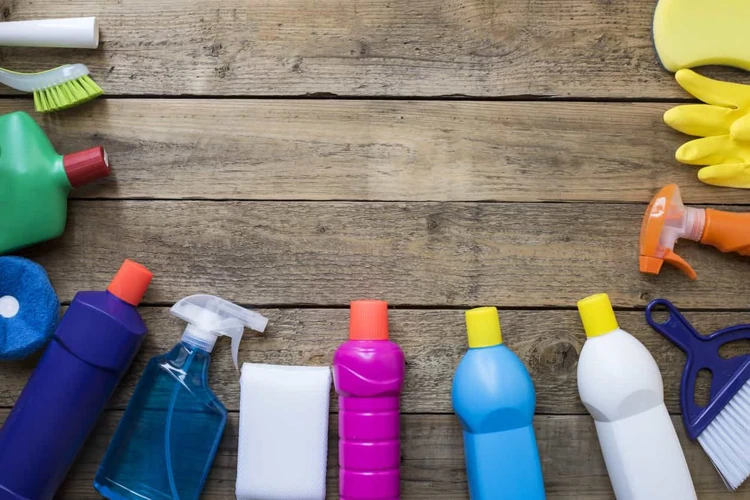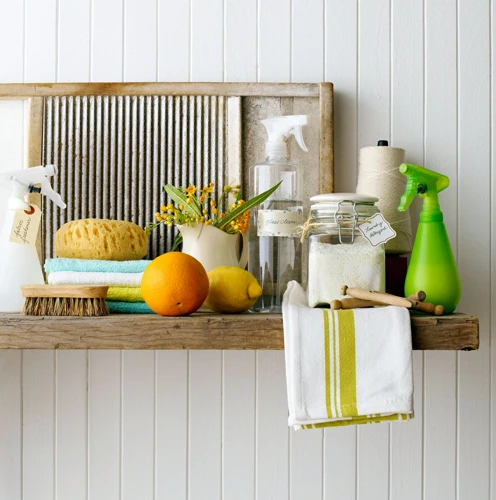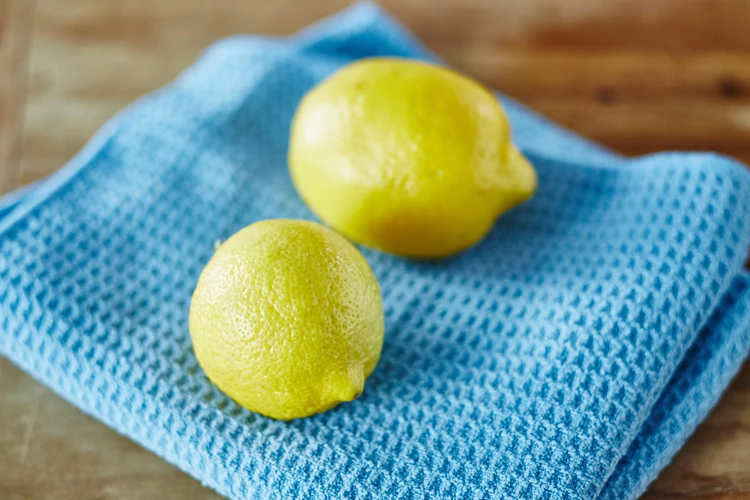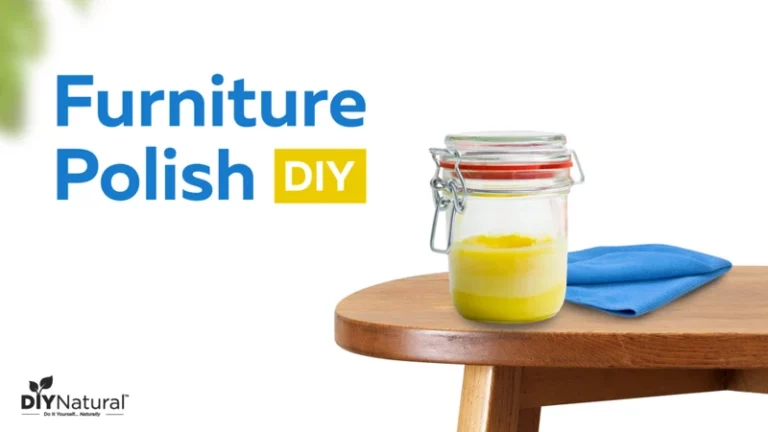Introduction

Polishing is an essential process to keep your household items clean, shiny, and attractive. However, most of the commercial polishes available in the market contain harsh chemicals that may pose a threat to the environment and your health. Fortunately, there are plenty of eco-friendly alternatives that you can easily make at home, using natural ingredients and reusable tools. In this section, we will guide you through some easy and fun DIY projects that will help you create your very own eco-friendly polishing tools. So let’s get started!
What are Eco-Friendly Polishing Tools?
Eco-friendly polishing tools are tools that do not harm the environment and can be used to clean and polish various surfaces around the house. These tools are made from natural ingredients, reusable materials or through DIY projects that promote sustainability. Eco-friendly polishing tools can be used to clean and polish surfaces such as wood, glass, metal, and countertops without leaving harmful chemicals behind.
Using eco-friendly polishing tools have several benefits. Firstly, natural ingredients used in making the tools are safe for use around pets and kids. Secondly, using eco-friendly polishing tools can help reduce the amount of toxins released into the environment from harsh chemical-based polishes. Eco-friendly polishing tools are cost-effective since many natural ingredients are readily available and can be bought in bulk, which is cheaper than buying chemical-based polishes.
Some examples of eco-friendly polishing tools include citrus furniture polish, vinegar-based window cleaner, olive oil brass polish, baking soda and lemon bathroom scrub, and DIY microfiber cloths. These tools are made from natural ingredients that are safe to use and can be used multiple times, making them sustainable alternatives to single-use products.
Maintaining eco-friendly polishing tools is also easy. They can be washed, cleaned and reused many times, thus reducing waste. Additionally, using eco-friendly polishing tools can help reduce the carbon footprint by eliminating the need for single-use products and preventing harmful chemicals from being released into the environment.
In contrast, using non-eco polishing tools such as chemical-based polishers can have a negative impact on the environment. The harsh chemicals can accumulate on the surfaces overtime and pose a health threat to pets and humans. By using eco-friendly polishing tools, we not only protect the environment but also reduce exposure to harmful chemicals.
In the future, the trend of using eco-friendly polishing tools is expected to increase. More eco-friendly polishing pads and wipes will be invented to provide more options for cleaning and polishing surfaces around the house.
Materials Required

When it comes to making your own eco-friendly polishing tools, there are a few key materials that you will need. By using natural ingredients and reusable tools, you can not only reduce waste and save money, but also create products that are safe for both you and the environment. In this section, we will highlight some of the essential materials required to make your own DIY eco-friendly polishing tools. To learn more about the benefits of using these tools, check out our article on the advantages of eco-friendly polishing.
Natural Ingredients
Natural ingredients are an excellent alternative to harsh chemicals found in conventional polishing products. Many natural ingredients have properties that make them effective at cleaning and polishing various surfaces around the house. Plus, using natural ingredients is eco-friendly and better for your health.
Here are some common natural ingredients you can use:
| Ingredient | Properties | Usage |
|---|---|---|
| Vinegar | Acidic properties that dissolve dirt and grime | Window cleaner, all-purpose cleaner, brass polish |
| Baking soda | Abrasive that helps remove stains and buildup | Bathroom cleaner, carpet deodorizer |
| Lemon | Natural disinfectant and stain remover | All-purpose cleaner, bathroom scrub, brass polish |
| Olive oil | Conditions and nourishes surfaces, such as wood and leather | Furniture polish |
| Citrus fruits (e.g. orange, grapefruit) | Natural solvents that dissolve grease and grime | Furniture polish |
Using natural ingredients is not only good for your household surfaces but also for the environment. By making your own polishing tools using natural ingredients, you reduce your environmental footprint by avoiding the use of conventional cleaning products that can harm the ecosystem.
To learn more about eco-friendly polishing tools and natural ingredients, please refer to our article on eco-friendly polishing tools.
Reusable Tools
Reusable tools are a key component of eco-friendly polishing. Unlike single-use products, such as disposable wipes or paper towels, reusable tools not only minimize waste but can also save you money in the long run. Here are some examples of reusable tools you can incorporate into your cleaning routine:
- Microfiber cloths: These cloths are made of fine synthetic fibers and are perfect for dusting, wiping down surfaces, and polishing. They are incredibly versatile and can be washed and reused hundreds of times. Check out our DIY Microfiber Cloth recipe in the next section for tips on making your own.
- Polishing pads: If you prefer a more traditional approach to polishing, consider investing in reusable polishing pads. Made from materials like wool or cotton, these pads can be used for everything from cleaning silver to polishing floors.
- Bottles and containers: Instead of buying new spray bottles and containers every time you need to mix up a cleaning solution, save and reuse the ones you already have. Glass or stainless steel containers are particularly good options, as they are durable and won’t leach harmful chemicals into your cleaning solutions.
- Buckets and mops: If you frequently mop your floors, consider switching to a reusable mop and bucket instead of disposable options. Look for cotton or microfiber mop heads that can be easily washed after use.
By incorporating these reusable tools into your cleaning routine, you can help minimize your impact on the environment and reduce your household waste. For more tips on eco-friendly cleaning tools, check out our Top 5 Eco-Friendly Polishing Tools article.
DIY Polishing Tools

As we strive towards a more sustainable lifestyle, DIY polishing tools made from natural ingredients and reusable materials offer a great way to minimize our impact on the environment. The following eco-friendly polishing tools can be easily created at home with common ingredients found in your kitchen. By making these polishes yourself, not only do you avoid harmful chemicals found in non-eco polish tools, but you’ll also save money, reduce waste, and maintain the surfaces in your house in a natural way.
Citrus Furniture Polish
Citrus comes with an amazing aroma and an added advantage of being eco-friendly, making it a perfect ingredient for DIY furniture polish. Citrus also has natural cleaning properties and can help dissolve dirt and grime, leaving your furniture looking shiny and polished. Here is a table with the ingredients and steps to make your own citrus furniture polish:
| Ingredients | Instructions |
|---|---|
| 1 cup of Olive Oil | Measure one cup of olive oil and pour it into a bowl |
| 1/2 cup of Lemon Juice | Add half a cup of lemon juice to the bowl containing olive oil |
| 1 teaspoon of Vinegar | Add a teaspoon of vinegar to the bowl and mix all the ingredients together |
| A few drops of Orange Essential Oil | Add a few drops of orange essential oil to the mixture and wait for it to settle |
| A spray bottle | Pour the mixture into the spray bottle |
To use the furniture polish, simply spray the mixture onto the surface of the furniture and use a microfiber cloth to buff it in circular motions. Once finished, your furniture will have a beautiful shine and will smell amazing too.
Using this DIY citrus furniture polish is a great way to avoid using harsh chemicals found in non-eco polishing products that can have harmful impacts on the environment. Plus, it’s a much cheaper and more sustainable way to keep your furniture polished and clean.
Vinegar-Based Window Cleaner
For an easy and effective vinegar-based window cleaner, you will need just a few simple ingredients that you may already have in your pantry. This eco-friendly alternative to traditional window cleaning products can be made in minutes, and without the use of harsh chemicals that may be harmful to both your health and the environment.
Materials Required:
| Materials | Quantity |
|---|---|
| Vinegar | 1/4 cup |
| Water | 1/4 cup |
| Essential oil (optional) | A few drops |
| Newspaper or rag |
To make this homemade window cleaner, simply mix 1/4 cup of vinegar and 1/4 cup of water in a spray bottle. If you prefer, you can add a few drops of your favorite essential oil, such as lemon or lavender, for a fresh scent. Shake the bottle well to mix the solution, and you are ready to clean your windows.
To use the vinegar-based window cleaner, simply spray the solution onto the glass and wipe it away with a crumpled-up piece of newspaper or a soft cloth. The vinegar’s acidity helps to break down dirt and grime, leaving your windows streak-free and clean.
By using this simple DIY window cleaner, you are avoiding the negative impact that non-eco polishing tools can have on both your health and the environment. Additionally, this method is a great way to maintain the cleanliness of your house surfaces with reusable tools, without the need to constantly purchase new cleaning products.
Olive Oil Brass Polish
To make an eco-friendly brass polish, all you need is some olive oil and white vinegar. Not only is this DIY polish non-toxic and chemical-free, but it is also very effective in cleaning and polishing brass objects. Here is how to make it:
| Materials needed: | Instructions: |
|---|---|
| Olive oil | Start by mixing 1/4 cup of olive oil and 1/4 cup of white vinegar in a bowl. |
| White vinegar | Stir the mixture until it is well combined. |
| Clean cloth | Dip a clean cloth into the mixture and rub it onto the brass surface. |
| Use a circular motion to apply the polish and make sure to cover the entire surface. | |
| Let the polish sit for a few minutes. | |
| Using a clean cloth, wipe the surface to remove any excess polish and reveal a shiny brass finish. |
This simple DIY brass polish is a great way to clean and maintain your brass objects without using any harmful chemicals. Additionally, using natural ingredients like olive oil and vinegar can help you save money and reduce your carbon footprint. To maintain the eco-friendliness of your polishing routine, remember to clean your reusable cloth after each use and store it in a dry place for future use. By incorporating this DIY polish into your regular cleaning routine, you can reduce your reliance on non-eco polishing tools and have a cleaner, more sustainable household.
Baking Soda and Lemon Bathroom Scrub
For an efficient and environmentally-friendly bathroom scrub, a mixture of baking soda and lemon can do wonders for cleaning sinks, toilets, and showers. Not only is this DIY solution effective, but it is also much cheaper and healthier than chemical alternatives. Here are the steps for creating your own baking soda and lemon bathroom scrub:
- Mix together 1/2 cup of baking soda and the juice of one whole lemon in a small bowl.
- Stir until the mixture becomes a paste.
- Apply the paste to the surfaces you want to clean, using a damp sponge or cloth.
- Scrub the surfaces gently, adding more paste if needed.
- Rinse the surfaces with water until all the baking soda residue is gone.
- Dry the surfaces with a clean cloth or towel.
This mixture is effective at removing stains and grime while also being gentle on surfaces. Baking soda acts as a natural abrasive, while the acidity of the lemon helps to break down dirt and soap scum. Plus, the lemon provides a refreshing scent and disinfectant properties.
Using this DIY scrub not only benefits your bathroom surfaces, but it also helps the environment by reducing your use of harsh chemicals that can contribute to water pollution and harm aquatic life. To further reduce your impact, consider using eco-friendly polishing pads and wipes that are reusable and free of harmful chemicals.
Remember to always maintain and reuse your eco-friendly polishing tools, instead of contributing to the mounting waste crisis with single-use products. By making these small changes, you can have a big impact on the health of your home and the planet.
DIY Microfiber Cloth
Creating your own microfiber cloth is not only eco-friendly but also cost-effective. These reusable cloths can be used for dusting, cleaning, and polishing household surfaces. They are also gentle enough to use on delicate items such as electronics and eyeglasses.
To make a DIY microfiber cloth, you will need:
| Materials: | Instructions: |
| Old t-shirts or towels | 1. Cut the fabric into squares or rectangles. 2. Sew the edges to prevent fraying. 3. Wash the cloth before use. |
| Scissors | |
| Sewing machine (optional) |
Tip: To make your DIY cloth even more eco-friendly, use old clothes that you would otherwise throw away.
Maintaining and reusing your DIY microfiber cloths is simple. After use, wash them with a mild soap and warm water. Air-dry them or tumble dry on low heat. Avoid using fabric softeners and bleach, which can reduce the effectiveness of the cloth.
By ditching disposable cleaning wipes and opting for an eco-friendly alternative like a DIY microfiber cloth, you not only reduce waste but also contribute to a healthier environment. Additionally, switching to eco-friendly cleaning tools can help keep harmful chemicals found in non-eco-friendly polish tools away from your household surfaces, and even your pets.
Tips for Eco-Friendly Polishing
When it comes to polishing your household items, there are several ways you can do so in an eco-friendly manner. However, it’s not just about using natural ingredients and reusable tools. There are also certain tips that can help you maintain a sustainable polishing routine. By following these tips, you can ensure that your polishing routine is not only effective but also environmentally friendly. So, let’s take a look at some of the ways you can keep your eco-polishing game strong. And if you want to learn more on how to maintain and reuse your eco-polishing tools, check out our article on maintaining and reusing eco polishing tools.
Avoid Harsh Chemicals
When it comes to eco-friendly polishing, one of the best tips to follow is to avoid harsh chemicals. Household cleaning products are often filled with chemicals that can be harmful to both the environment and your health. These chemicals can cause air pollution, water pollution and even result in respiratory problems, skin irritations and other health issues. Instead, opting for natural solutions not only benefits the environment, but also provides a safer alternative for you and your family.
Here are some harsh chemicals to avoid:
- Ammonia – commonly found in window cleaners and can cause irritation to the lungs and eyes.
- Bleach – often used to clean and disinfect surfaces, but its harsh fumes can cause breathing problems and skin irritation
- Phthalates – often found in fragranced cleaning products and can cause hormone imbalances and developmental issues in children.
- Perchloroethylene – often found in dry cleaning solvents and can cause dizziness, headaches, and even liver and kidney damage.
- Triclosan – often found in antibacterial soaps and can disrupt hormone balance and contribute to antibiotic resistance.
By avoiding these harsh chemicals, you can reduce your environmental impact and protect your health. Instead, opting for natural ingredients and reusable tools can be effective and safe for both you and the environment.
For example, using vinegar and baking soda for cleaning or opting for a DIY microfiber cloth can help to reduce the use of harsh chemicals in your home. Additionally, consider using eco-friendly pet polishing tools such as pet hair removers made from recycled materials. You can find more information on eco-friendly pet polishing tools in our article “Eco-Friendly Pet Polishing Tools”.
Avoid Single-Use Products
One of the key steps to eco-friendly polishing is to avoid single-use products. These products are designed to be used once and then thrown away, contributing to the growing problem of waste in our landfills and oceans. To help reduce waste, consider incorporating reusable tools and products into your cleaning routine. Here are some examples:
| Single-Use Product | Reusable Alternative |
|---|---|
| Paper towels | Cloth rags or washable microfiber cloths |
| Cotton balls | Reusable makeup remover pads |
| Disposable cleaning wipes | Cloth rags or washable cleaning cloths |
| Plastic scrubbing pads | Durable scrubbing brushes or sponges |
Making the switch to reusable products can help reduce waste and save money in the long run. Plus, many reusable products are made of sustainable materials like bamboo, making them an even more eco-friendly choice for your household.
Reuse and Recycle
One of the core principles of eco-friendly cleaning is reducing waste. Instead of buying single-use cleaning tools, opt for reusable materials that can be re-purposed in your cleaning routine. Here are some items to consider reusing:
- Glass Jars: Don’t throw away your old pasta sauce jars! Clean them out and use them as storage containers for homemade cleaning solutions.
- Old Clothes: Cut up old t-shirts or towels and use them as rags for cleaning surfaces.
- Old Toothbrush: Don’t toss your old toothbrushes. They can be used for scrubbing grout and other hard-to-reach areas.
- Newspaper: Instead of using disposable paper towels for window cleaning, use old newspapers to reduce waste.
In addition to reusing, make sure to properly recycle any materials that are no longer usable. Check with your local recycling program to see what can and cannot be recycled in your area. By reducing waste and properly recycling, you can make a positive impact on the environment while still keeping your home clean and polished.
Conclusion
As we reach the end of this article, it’s exciting to reflect on the potential benefits of opting for eco-friendly polishing tools in your household. By choosing to utilize natural ingredients and reusable tools, you not only take a step towards a more sustainable lifestyle but also contribute to a healthier environment. Let’s delve deeper into some of the advantages and joys of embracing DIY eco-friendly polishing projects.
Benefits of Eco-Friendly Polishing
Eco-friendly polishing has many benefits for both you and the environment. Here are just a few:
| Benefit | Description |
|---|---|
| Healthier Home Environment | Using natural ingredients and avoiding harsh chemicals can create a healthier home environment by reducing exposure to toxic fumes and irritating residues. |
| Better Indoor Air Quality | Harsh chemicals in cleaning products can lead to poor indoor air quality, which can exacerbate respiratory problems. Eco-friendly polishing reduces exposure to these chemicals. |
| Reduced Environmental Impact | Making and using your own cleaning products with natural ingredients reduces the amount of chemicals that are released into the environment, reducing the overall environmental impact. |
| Cost-Effective | Many natural ingredients used in eco-friendly polishing are inexpensive and readily available, making it a cost-effective alternative to store-bought products. |
| Customizable | Eco-friendly polishing tools can be easily customized to suit your specific needs and preferences. For example, you can adjust the amount of essential oils in your furniture polish to vary the scent and strength. |
Eco-friendly polishing can also be a fun and rewarding DIY project, allowing you to take control of the cleaning products in your home and showcase your creativity. By using natural ingredients and reusable tools, you can create an eco-friendly cleaning routine that is both effective and sustainable.
Easy and Fun DIY Projects
Taking steps towards using eco-friendly polishing tools in your household can also be fun and easy. By creating your polishing solutions, you not only save money, but also benefit the environment. Here are some DIY polishing projects that you can try out:
- Citrus Furniture Polish: Mix half a cup of lemon juice with a cup of olive oil in a spray bottle. Spray the mixture onto your furniture and wipe it with a microfiber cloth. The lemon juice acts as a cleaning agent, while the olive oil provides a protective shine.
- Vinegar-Based Window Cleaner: Mix equal parts water and vinegar in a spray bottle. Spray the mixture onto your windows and wipe it with a microfiber cloth for a streak-free finish. Vinegar is a natural disinfectant and can tackle tough stains on your windows.
- Olive Oil Brass Polish: Mix one tablespoon of olive oil with one tablespoon of baking soda to form a paste. Apply the paste onto your brass surface and buff it out with a microfiber cloth to reveal its shine.
- Baking Soda and Lemon Bathroom Scrub: Mix a quarter cup of baking soda with lemon juice to form a paste. Apply the paste onto your bathroom surface and scrub it off with a reusable scrub brush, then rinse it off with water. Baking soda helps remove grime and stains, while the lemon juice provides a fresh scent and acts as a cleaning agent.
- DIY Microfiber Cloth: Make your own reusable microfiber cloth by cutting up an old T-shirt or towel into small pieces. The cloth can be washed and reused multiple times, instead of using single-use paper towels.
By trying out these DIY projects, you can have fun while being environmentally conscious. Not only are these projects simple to make, but they are also effective at cleaning and polishing your household items. Give them a try and see the difference they make!
Frequently Asked Questions
What makes DIY Eco-Friendly Polishing Tools different from store-bought products?
DIY Eco-Friendly Polishing Tools are made with natural ingredients and reusable tools, which reduce waste and limit exposure to harsh chemicals.
Why should I switch to Eco-Friendly Polishing?
Eco-Friendly Polishing reduces the amount of harsh chemicals in your household and limits the waste produced by single-use products. Plus, making your own polishing tools can be a fun and creative project.
What ingredients are needed for Eco-Friendly Polishing Tools?
Some common natural ingredients include vinegar, lemon juice, olive oil, and baking soda.
Where can I find reusable tools for Eco-Friendly Polishing?
Reusable tools can often be found in thrift stores or online marketplaces. You can also repurpose items such as old t-shirts or towels as cleaning cloths.
How do I make Citrus Furniture Polish?
Mix together equal parts lemon juice and olive oil, and apply with a cloth. Buff the surface until it shines.
Can I use Vinegar-Based Window Cleaner on all types of windows?
Vinegar-Based Window Cleaner can be used on most window surfaces, but it is recommended to test on a small area first to avoid damage.
What is the best way to use Olive Oil Brass Polish?
Apply a small amount of olive oil to a cloth and rub onto the brass surface. Polish with a dry cloth until shiny.
How do I make Baking Soda and Lemon Bathroom Scrub?
Mix together baking soda and lemon juice until a paste is formed. Apply to surfaces and scrub with a brush or cloth.
Why should I avoid harsh chemicals in my household cleaning products?
Harsh chemicals can be harmful to both your health and the environment. Reducing their use can lead to a cleaner and healthier home and planet.
How can I reuse and recycle while Eco-Friendly Polishing?
You can repurpose old t-shirts or towels as cleaning cloths and use glass jars or spray bottles for storage. You can also recycle any packaging or containers used for your natural ingredients.
